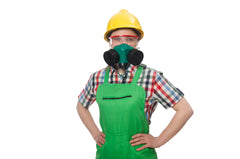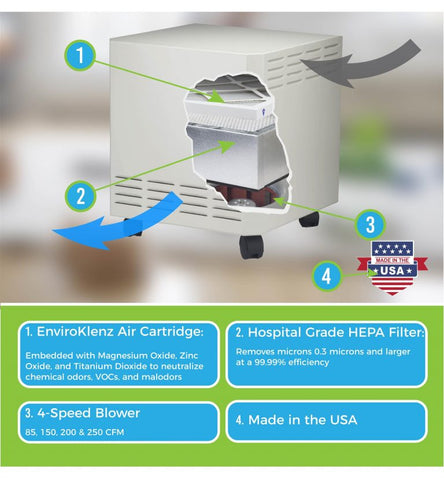
How to Prevent & Control Indoor Air Pollution & Why It's Important
Where are you right now at this moment? Chances are that you are inside, sitting behind your computer or on your phone reading this article. For many, you spend considerably more time indoors than outdoors, whether in your home, at work sitting behind a computer, inside a mall, eating in a restaurant, and a whole plethora of other activities that are spent in between four walls, away from the outdoor environment.
The Environmental Protection Agency (EPA) estimates that most Americans spend up to 90 percent of their time indoors, so indoor air quality is vitally important to your health.
Is your personal environment tainted with polluted air that could be affecting your health?
And if your indoor air is polluted how can you prevent & control this indoor air pollution?
Indoor Air Quality Facts to Consider
As researchers develop links to air pollution and many diseases and health ailments, the study of indoor air pollution has emerged as an important element of health and wellbeing. As more information is understood about indoor air quality's effect on human health, the EPA has published surprising information and facts on indoor air quality to consider.- The Environmental Protection Agency ranked indoor air quality as a top five environmental danger to human health
- The quality of indoor air can be two to five times more polluted than the worst outdoor air
- Furniture in your home could be a potential cause of indoor air pollutants in your home, as PBDEs – chemicals used in flame retardants -can be used in your furniture
- Air fresheners and candles in your home could be releasing harmful chemicals into your environment such as carcinogens, and phthalates, that can impact your health
- Poor air quality has increased asthma diagnosis, with an estimated 25 million Americans suffering from asthma
- Sixty percent of indoor air quality problems are related to ventilation and thirty percent result from air contamination, twenty percent from inside the building and ten percent from outside the building
How to Check Air Quality in Your Home
Determining the quality of the air in your home can be difficult. In home air quality test meters are available, but for many, your body can be the ultimate air quality check in your home.
The health effects that you are experiencing may be useful indicators of an indoor air quality problem, especially if these symptoms occur in a new environment or when in the presence of a change in your environment such as new furniture, new cleaning products, or new flooring in your home.
Becoming more familiar with the potential sources of indoor air pollution can also be an important component to ensuring prevention and control of poor air quality in your home.
Key Sources of Indoor Air Pollution: Know the Pollutants
Your indoor space can have many kinds of indoor pollutants such as formaldehyde, benzene, asbestos, biological pollutants, carbon monoxide, lead, nitrogen dioxide pesticides, radon, indoor particulate matter, and VOCs.
In some cases, certain indoor air pollutants may even be 100 times higher than outdoor air pollutants. Determining the sources of these pollutants in your indoor environment will help to combat and control indoor air pollution.
Steps to Take to Prevent & Control Indoor Air Pollution
Taking into account the increasing indoor air quality concerns and dangers, here are some steps to implement to properly prevent and control indoor air pollution.
1.) Reduce Chemical Pollutants
Hundreds of potentially harmful chemicals are emitted and released into your personal environment every day. Household cleaning agents, personal care products, paint, and solvents used on a regular basis can severely impact your indoor air and your health.
To reduce chemical pollutants in your home, eliminate the use of air fresheners and candles in your home, as well as perfumes that you spray into the air. Toxic chemicals such as carcinogens and phthalates are emitted into the air from candles and air fresheners. Studies show that Phthalates can disrupt your endocrine system, and due to lax labeling regulations in the US, you won't find ingredients like Phthalates listed on your product's label.
2.) Perform Smart Cleaning
Household cleaners can contain toxic chemicals that can make their way into your home’s air and impact your air quality significantly. A key ingredient in many window, kitchen, and multipurpose cleaners called 2-Butoxyethanol is a culprit that can not only contaminate and taint the indoor air but also lead to an array of potential health problems.
According to the EPA, in addition to causing sore throats when this chemical is inhaled when in high amounts, it can contribute to narcosis, pulmonary edema, and severe liver and kidney damage. To avoid these consequences of using this chemical, use alternative cleaning products such as natural, non-toxic cleaning agents that are safe for you and your environment, making your cleaning and laundry process safer and more effective.
3.) Ventilation & Moisture Control
Is there a spot in your home that accumulates far more moisture than it should, making you wonder about mold growth?
Kitchens, bathrooms, and basements are all areas where moisture can gather. Where there is moisture, mold will find a home and start its takeover of your home and air.

In recent years, home builders have designed homes with a tight configuration in to improve efficiency. Though this idea promotes a sustainable lifestyle, it can lead to a lack of ventilation in the home and, even worse, the potential for moisture and mold to grow in these areas.
When mold forms, it can release mold spores into your home’s air which can cause health issues. To prevent this from happening, make sure you have proper ventilation especially in areas where moisture can build-up, add a vent fan to this area, use an air purifier, or open windows to allow for air flow in and out of your home to alleviate moisture and ventilation issues in your home.
4.) Air Purification with a True HEPA Air Filter
What can you do to filter out these pollutants and improve the air quality in your home?
An air purification system with a true HEPA air filter will take in the pollutants in your indoor air and break them down, eliminating them from your air flow.
The EnviroKlenz Mobile System not only contains a true, medical-grade HEPA air filter, but it also utilizes a patented earth mineral technology air cartridge that removes a broad spectrum of odors and chemicals from your indoor air.

This two-stage filtration device will work effectively against odors and chemicals, as well as small particles that can be potentially hazardous to your health. Learn more about this safe and effective EnviroKlenz Mobile System and how it can prevent & control indoor air pollution in your home today.
If an air purifier isn't for you, then consider using an HVAC filter that removes VOCs. The EnvironKlenz air cartridges replace your existing air filter cartridge in your HVAC system and are tested to reduce common household VOCs like formaldehyde.
See the results below. The chart shows VOC reduction using an EnviroKlenz HVAC Filter over 30 day period inside a house and basement that had high levels of VOCs measured in PPM (parts per million). Over a 15 day period, the EnvironKlenz reduced the VOCs levels and kept them low.

Learn more about HVAC air cartridges that clean your indoor air.

